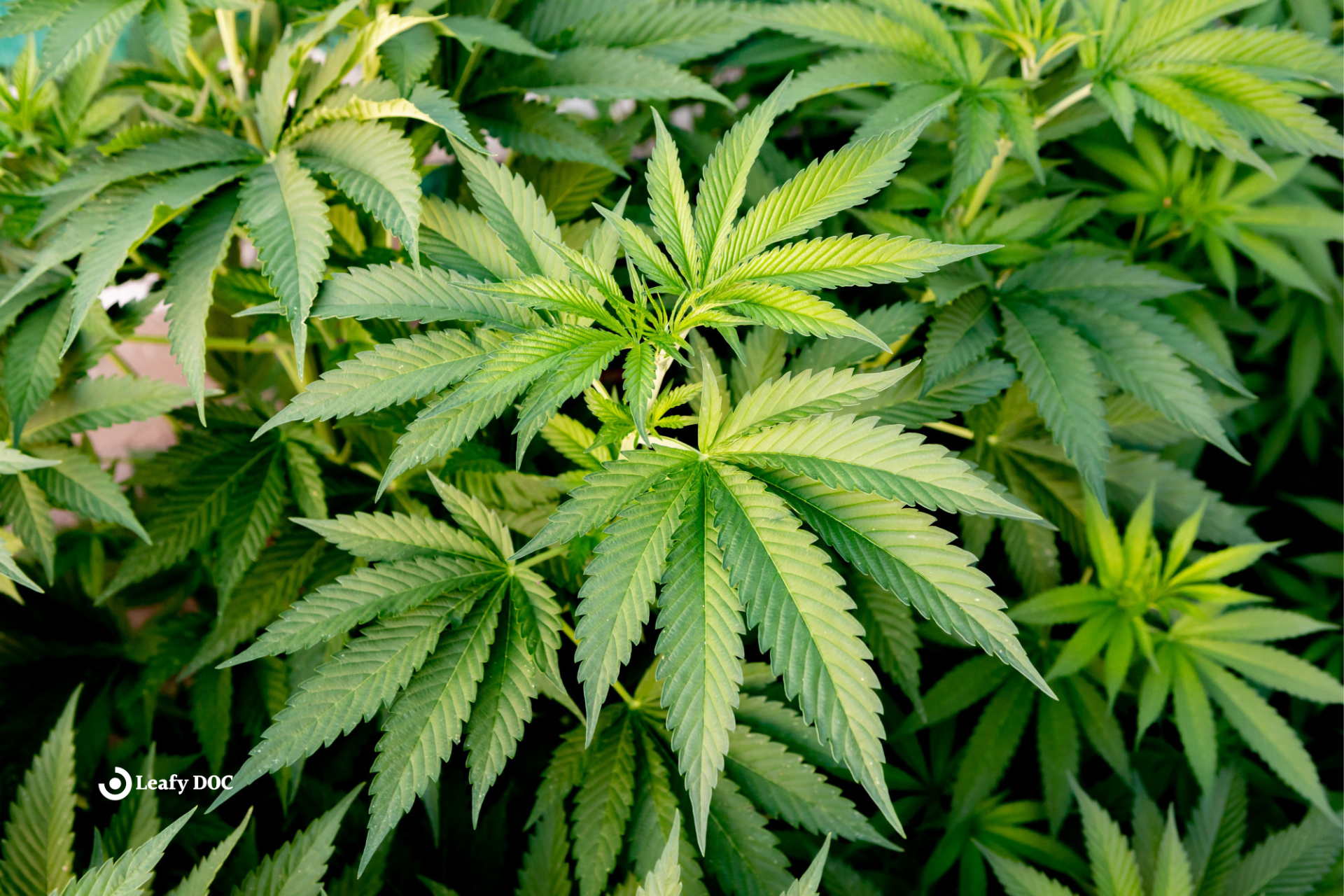Medical Marijuana for Parkinson’s Disease: Can it Help?
by Haley Mills · May 18, 2023
Discover how medical marijuana can help treat symptoms of Parkinson’s disease and improve the quality of life for patients. Learn about the potential benefits of using cannabis for Parkinson’s.

Parkinson’s disease (PD) is a debilitating neurodegenerative disorder characterized by motor and non-motor symptoms, significantly affecting the quality of life for those diagnosed. With limited treatment options and no cure, patients are increasingly turning to alternative therapies with medical marijuana gaining popularity. MMJ has generated significant interest as a potential treatment option. Drawing from the insights of Parkinson’s organizations and the National Center for Biotechnology Information (NCBI), this article uncovers the potential benefits and limitations of medical marijuana for PD patients.
Understanding Parkinson’s Disease: Symptoms and Causes
Parkinson’s disease (PD) is a progressive neurodegenerative disorder that affects approximately 10 million people worldwide. The disease primarily impacts the dopaminergic neurons in a region of the brain called the substantia nigra, leading to a decline in dopamine levels. Dopamine is a neurotransmitter that regulates movement, mood, and other essential functions. The exact cause of PD is still not completely understood, but it is believed to involve a combination of genetic and environmental factors.
The symptoms of Parkinson’s disease can be broadly categorized into motor and non-motor symptoms. Motor symptoms include tremors, rigidity, bradykinesia (slow movement), and postural instability. Non-motor symptoms encompass various issues, such as sleep disturbances, cognitive impairment, mood disorders, and autonomic dysfunction. These symptoms can vary greatly between individuals and often progress over time, significantly impacting patients’ quality of life.
Conventional Treatment Options for Parkinson’s Disease
Currently, there is no cure for Parkinson’s disease. The primary goal of treatment is to manage symptoms and maintain the highest possible quality of life for patients. The most common treatment strategy involves using medications to increase or mimic the effects of dopamine in the brain. Levodopa is a precursor to dopamine and is often combined with carbidopa to enhance its effectiveness and reduce side effects. Other medications include dopamine agonists, which mimic the action of dopamine, and medications that slow the breakdown of dopamine, such as monoamine oxidase B (MAO-B) inhibitors and catechol-O-methyltransferase (COMT) inhibitors.
In addition to medications, physical therapy, occupational therapy, and speech therapy can help patients manage motor symptoms and maintain their independence. In some cases, surgical interventions like deep brain stimulation (DBS) may be recommended for patients with advanced PD or those who do not respond well to medications.
The Endocannabinoid System: A Primer
The endocannabinoid system (ECS) is a complex cell-signaling system that plays a role in maintaining the balance and regulation of various physiological processes, including mood, appetite, sleep, and immune response. The ECS consists of three main components: endocannabinoids, receptors, and enzymes. Endocannabinoids are naturally occurring compounds structurally similar to the active compounds found in cannabis, known as cannabinoids.
There are two primary types of endocannabinoid receptors: CB1 and CB2 receptors. CB1 receptors are primarily found in the brain and central nervous system, while CB2 receptors are more abundant in the peripheral organs and immune cells. When endocannabinoids bind to these receptors, they trigger various cellular responses that help maintain homeostasis in the body.
The link between the endocannabinoid system and Parkinson’s disease is an area of ongoing research. Studies have found that the ECS may play a role in modulating neuroinflammation, neuroprotection, and neurotransmitter release, all of which are implicated in the development and progression of PD. This has increased interest in using cannabinoids as a therapeutic option for PD patients.
Medical Marijuana: Components and Forms
Medical marijuana, also known as medical cannabis, refers to using the Cannabis sativa plant or its derivatives to alleviate symptoms of various medical conditions. The plant contains over 100 chemical compounds called cannabinoids, with delta-9-tetrahydrocannabinol (THC) and cannabidiol (CBD) being the most studied and well-known. THC is the psychoactive component responsible for the “high” associated with marijuana use, while CBD is non-psychoactive and has been linked to various potential therapeutic benefits.
Medical marijuana is available in several forms, including dried flowers for smoking or vaporizing, oils and tinctures for oral consumption or sublingual administration, edibles, capsules, and topical creams or balms. The choice of form and ratio of THC to CBD often depends on the patient’s specific needs and preferences and their healthcare provider’s recommendations.
Cannabinoids and Parkinson’s Disease: Theoretical Basis
Cannabinoids are thought to have potential therapeutic effects in Parkinson’s disease medical marijuana due to their interaction with the endocannabinoid system. As mentioned, the ECS regulates various physiological processes, including neuroprotection and neurotransmitter release. In PD, cannabinoids may help alleviate symptoms by modulating dopamine release, reducing neuroinflammation, and providing neuroprotective effects.
For example, studies have suggested that THC may help specific PD symptoms. It can reduce tremors and spasticity by activating CB1 receptors in the basal ganglia, a brain region involved in motor control. Conversely, CBD has been shown to have anti-inflammatory and antioxidant properties, which could help protect dopaminergic neurons from damage and slow disease progression.
Clinical Studies: Investigating the Efficacy of Medical Marijuana in PD Treatment
While the theoretical basis for the use of medical marijuana in Parkinson’s disease is promising, clinical research on its efficacy and safety is still limited. Most studies conducted thus far have been small-scale, observational, or open-label trials, less rigorous than randomized controlled trials (RCTs).
A small study published in the Journal of Psychopharmacology in 2014 found that Parkinson’s patients who used cannabis experienced a significant improvement in motor and non-motor symptoms and an increased quality of life. However, this study was based on self-reporting by patients, which may be subject to bias.
Another study published in Clinical Neuropharmacology in 2017 found that a four-week treatment with CBD improved the quality of life and well-being in PD patients but did not significantly impact motor symptoms. More significant, well-designed clinical trials are needed to confirm these findings and establish the optimal dosage and form of medical marijuana for PD patients.
Relief from Motor Symptoms: Tremors, Rigidity, and Dyskinesia
Some Parkinson’s patients have reported improved motor symptoms after using medical marijuana. Tremors, rigidity, and dyskinesia are among the most common motor symptoms experienced by PD patients, and they can significantly affect daily functioning and quality of life.
Preliminary studies suggest that THC, the psychoactive component of cannabis, may help reduce tremors by activating CB1 receptors in the basal ganglia, which regulate motor control. Additionally, anecdotal reports indicate that some patients experience reduced rigidity and dyskinesia with medical marijuana use. However, the evidence supporting these claims is primarily anecdotal or based on small-scale studies. Rigorous clinical trials are needed to determine the effectiveness of medical marijuana for motor symptom relief in PD patients.
Non-Motor Symptoms: Improvements in Sleep, Mood, and Cognition
Parkinson’s disease is associated with various non-motor symptoms, including sleep disturbances, mood disorders, and cognitive impairment. Some research has suggested that medical marijuana may help alleviate these symptoms in PD patients.
For example, CBD has been shown to have anxiolytic and antidepressant properties, which may help improve mood and reduce anxiety in PD patients. Additionally, medical marijuana has been reported to help with sleep disorders, such as insomnia and REM sleep behavior disorder, which are common in Parkinson’s patients. Some studies have also indicated that cannabinoids may have neuroprotective effects, potentially helping to maintain cognitive function in PD patients. However, more research is needed to determine how much medical marijuana can improve non-motor symptoms in Parkinson’s patients.
Medical Marijuana as an Adjunct Therapy: The Pros and Cons
Medical marijuana is often considered an adjunct therapy for Parkinson’s disease, meaning it is combined with conventional treatments to enhance its effectiveness or manage side effects. There are potential benefits and drawbacks to this approach.
One of the main benefits of using medical marijuana as an adjunct therapy is that it may help improve PD patients’ overall quality of life by addressing symptoms not well managed by conventional treatments. Additionally, some research suggests that cannabinoids may synergize with other medications, potentially enhancing their therapeutic benefits.
However, there are also potential risks and drawbacks to consider. One concern is the potential for drug interactions between medical marijuana and conventional PD medications. For example, cannabinoids may interact with certain enzymes in drug metabolism, potentially affecting how the body processes other medications. The psychoactive effects of THC may be undesirable for some patients, leading to dizziness, cognitive impairment, or increased anxiety. The lack of standardized dosing guidelines and the varying legal status of medical marijuana can make it challenging for patients and healthcare providers to navigate its use as an adjunct therapy.
Potential Side Effects and Risks of Medical Marijuana for PD Patients
While medical marijuana has shown promise for alleviating some symptoms of Parkinson disease, it is essential to consider its potential side effects and associated risks. Common side effects of medical marijuana include dizziness, dry mouth, increased heart rate, blood pressure fluctuations, and impaired short-term memory. These side effects may be more pronounced in older adults or those with pre-existing medical conditions.
Additionally, long-term use of medical marijuana, particularly products high in THC, may be associated with an increased risk of developing psychiatric symptoms such as anxiety, depression, or even psychosis. Patients with a history of mental health issues should discuss these risks with their healthcare provider before smoking marijuana.
Another concern is the potential for dependence or addiction, particularly for THC products. Although the risk of marijuana withdrawal symptoms is generally lower than that of other substances, such as opioids, it is still essential for patients and healthcare providers to be aware of this potential risk and monitor usage accordingly.
Legal and Regulatory Challenges Surrounding Medical Marijuana
The legal status of medical marijuana varies significantly between countries and even within individual states or provinces. This variation in regulations can create confusion and challenges for patients seeking to obtain medical marijuana for Parkinson’s disease. Some jurisdictions may require patients to obtain a prescription or medical marijuana card, while others may have no specific regulations.
Moreover, the lack of standardization and quality control in the production and distribution of medical marijuana products can lead to inconsistencies in potency, purity, and safety. Patients must be cautious when selecting medical marijuana products. They should consult a knowledgeable healthcare provider to ensure they use a product that meets their needs and complies with local regulations.
Guidelines for PD Patients Considering Medical Marijuana
For Parkinson’s patients considering medical marijuana as a treatment option, it is crucial to follow a few guidelines to ensure the best possible outcome:
- Consult with a healthcare provider experienced in medical marijuana use. They can help determine if medical marijuana is appropriate for your situation and guide you in selecting the right product and dosage.
- Start with a low dose and titrate slowly. This approach helps minimize side effects and allows you to find the most effective dose for your symptoms.
- Monitor your symptoms and side effects closely. Keep a journal to track any changes in your symptoms, side effects, or overall well-being while using medical marijuana. Share this information with your healthcare provider to help guide adjustments to your treatment plan.
- Be aware of the legal status of medical marijuana in your jurisdiction. Understand the regulations governing medical marijuana use and ensure you comply with local laws.
- Use caution when driving or operating heavy machinery while using medical marijuana, as it may impair cognitive and motor function.
Future Research Directions: Unlocking the Potential of Cannabis for PD Treatment
Medical marijuana has shown promise in alleviating some symptoms of Parkinson’s disease, multiple sclerosis, and other neurological and psychiatric disorders, including motor and non-motor symptoms. While research is still in its infancy, preliminary findings indicate potential benefits in managing tremors, rigidity, sleep disturbances, and mood issues. However, there are also concerns about side effects, drug interactions, and the lack of standardized dosage recommendations.
As the legal landscape surrounding medical marijuana evolves and more research is conducted, it is crucial for PD patients to consult with their healthcare providers to make informed decisions about incorporating cannabis into their treatment plans.
Last Updated: August 8, 2024
Get Approved for Your Medical Marijuana Card in Minutes!

Get Your Medical Card
Connect with a licensed physician online in minutes

Like This Article?
Share with your friends
Table of Contents
Keep Reading
-
Exploring The Possible Interactions Of Medical Marijuana With Medications
Unlock the potential of medical marijuana! Learn about its interactions with medications and discover new alternative treatments. Click here to explore this fascinating topic now.
-
Latest Cannabis Research Breakthroughs You Should Know
Stay ahead of the game with the latest cannabis research breakthroughs! Unlock the potential of this incredible plant and discover groundbreaking discoveries that will change everything. Click now to stay in the know and be a part of the cannabis revolution.
-
Can I Buy Medical Marijuana Edibles in PA?
Explore the top edibles in PA’s medical marijuana market. Find the right products for you and learn about the different strains and flavors.



